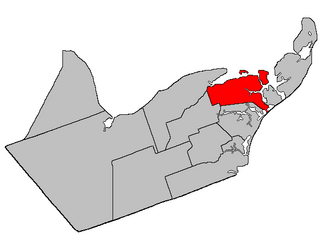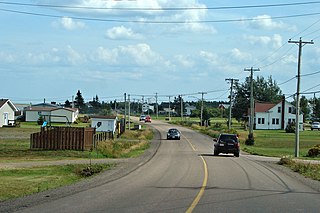
Saumarez is a geographic parish in Gloucester County, New Brunswick, Canada.

Aberdeen is a geographic parish in Carleton County, New Brunswick, Canada, located in the interior east of the Saint John River.

Beresford is a geographic parish in Gloucester County, New Brunswick, Canada.
A local service district (LSD) was a provincial administrative unit for the provision of local services in the Canadian province of New Brunswick. LSDs originally covered areas of the province that maintained some services but were not made municipalities when the province's former county municipalities were dissolved at the start of 1967; eventually all of rural New Brunswick was covered by the LSD system. They were defined in law by the Local Service Districts Regulation of the Municipalities Act. In 2017, the Municipalities Act was replaced by the Local Governance Act, which continued the Local Service Districts Regulation.

Inkerman is a geographic parish in Gloucester County, New Brunswick, Canada.

Northampton is a geographic parish in Carleton County, New Brunswick, Canada, sitting across the Saint John River from Woodstock.

Dalhousie is a geographic parish in Restigouche County, New Brunswick, Canada.

Bathurst is a geographic parish in Gloucester County, New Brunswick, Canada.

New Bandon is a geographic parish in Gloucester County, New Brunswick, Canada.

Caraquet is a geographic parish in Gloucester County, New Brunswick, Canada.

Shippegan is a geographic parish in Gloucester County, New Brunswick, Canada. Located in the northeastern corner of the province at the end of the Acadian Peninsula, the parish consists of the three main islands of Taylor, Lamèque, and Miscou, along with several smaller islands and tidal wetlands; Taylor Island is now joined to the mainland by an isthmus, which is crossed by a causeway.

Saint-Isidore is a geographic parish in Gloucester County, New Brunswick, Canada.

Allardville is a geographic parish in Gloucester County, New Brunswick, Canada,

Wellington is a geographic parish in Kent County, New Brunswick, Canada.

Peel is a geographic parish in Carleton County, New Brunswick, Canada, situated on the eastern bank of the Saint John River.

Woodstock is a geographic parish in Carleton County, New Brunswick, Canada, surrounding the town of the same name on its landward side.

Dumbarton is a geographic parish in Charlotte County, New Brunswick, Canada, located inland north of St. George and south of Harvey.

Saint Stephen is a geographic parish in Charlotte County, New Brunswick, Canada, located in the southwestern corner of the province.

Saint James is a geographic parish in Charlotte County, New Brunswick, Canada, located north of St. Stephen.

Saint David is a geographic parish in Charlotte County, New Brunswick, Canada, located northeast of St. Stephen and northwest of Saint Andrews.



















